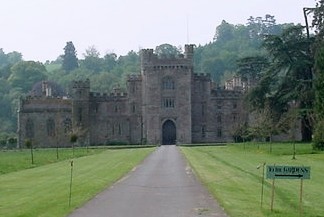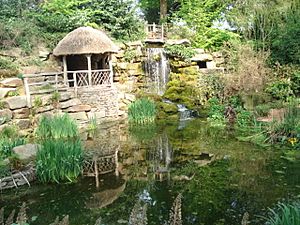Hampton Court Castle facts for kids
Quick facts for kids Hampton Court Castle |
|
|---|---|

Hampton Court Castle, seen from the north.
|
|
| General information | |
| Architectural style | Gothic, Gothic Revival |
| Location | Hope under Dinmore, England |
| Coordinates | 52°10′3.57″N 2°42′14.91″W / 52.1676583°N 2.7041417°W |
| Construction started | 1427 |
Hampton Court Castle, also known simply as Hampton Court, is a large country house in Herefordshire, England, that is built to look like a castle. It is located about four miles south of the town of Leominster. Because of its historical importance, it is a Grade I listed building, which is the highest level of protection for buildings in England.
Today, the castle and its beautiful grounds are open for the public to visit. It is also a popular place for weddings and other special events.
Contents
The Castle's Long History
The story of Hampton Court begins all the way back in 1427. A knight named Sir Rowland Lenthall built the first house on the land. He received the estate when he married Margaret Fitzalan, who was a cousin of the king.
The original house was built in a square shape around a central open area called a courtyard. This basic shape can still be seen today, but many other parts of the house have been changed over the centuries.
The famous artist J.M.W. Turner found the castle so impressive that he painted it at least two times.
Who Has Lived at the Castle?
Over its long life, Hampton Court Castle has had many different owners who have all left their mark on the building.
Early Owners and Changes
From 1510 to 1781, the castle belonged to the Coningsby family, a noble family in the area. After them, it was passed to George Capel-Coningsby, the 5th Earl of Essex. He hired a famous architect to redesign parts of the building.
During the 1700s and early 1800s, other architects like Colen Campbell and Sir Jeffrey Wyatville also made changes to the castle.
The Arkwright Family
In 1810, the castle was bought by John Arkwright. He was the grandson of Richard Arkwright, a famous inventor who played a big part in the Industrial Revolution. The Arkwright family owned the castle for over 100 years.
During the 1830s and 1840s, they worked to make the house look more like a medieval castle again. They wanted to undo earlier changes that had made it look like a regular home.
Modern Times
The Arkwright family sold the castle in 1910. After that, it was owned by several different people. From 1924 to 1972, it was the home of the Viscount Hereford.
In 1994, an American businessman named Robert Van Kampen bought the castle. He and his family put a lot of work into creating the amazing gardens that people can visit today. After Mr. Van Kampen passed away, his family sold the castle in 2006.
As of 2024, the castle is still used as a wedding location and is open to the public on certain days. The gardens are open for visitors throughout the summer season.
Exploring the Amazing Gardens
The gardens at Hampton Court are one of its most famous features. They cover 12 acres and are full of exciting things to discover.
Some of the highlights include:
- A large maze to get lost in.
- A secret tunnel to explore.
- A beautiful Dutch-style garden.
- A stunning archway covered in wisteria flowers that is 150 years old.
- A sunken garden with a waterfall.
- An organic kitchen garden, where fruits and vegetables are grown naturally.
The gardens often host special events like outdoor plays, concerts, and fun days for families.
Hampton Court on TV
The castle and its grounds were used as a major filming location for the first season of a 1970s BBC television show called Survivors.


